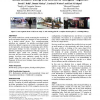Free Online Productivity Tools
i2Speak
i2Symbol
i2OCR
iTex2Img
iWeb2Print
iWeb2Shot
i2Type
iPdf2Split
iPdf2Merge
i2Bopomofo
i2Arabic
i2Style
i2Image
i2PDF
iLatex2Rtf
Sci2ools
CSCW
2008
ACM
2008
ACM
Small details: using one device to navigate together
We present results from a study examining the sensitivity of group navigation strategies to changes in route presentation on a shared mobile device. Two content-equivalent interfaces are compared. An interface providing textual instructions linked to regions on a route map yields reliance on text primarily, encouraging route planning and a divideand-conquer strategy we term `navigator and scout'. An interface combining text instructions with map segments on individual pages yields less planning, still permits nav/scout, and sees an increase in an ad-hoc `sync and go' strategy involving more gathering around the device. Finally, when the route map is used without text, the frequency of the nav/scout strategy drops markedly as sync and go increases. Author Keywords Mobile maps, group navigation, sharing mobile phones. ACM Classification Keywords H5.3. [Information interfaces and presentation]: Group and Organization Interfaces---Collaborative computing.
Related Content
| Added | 19 Oct 2010 |
| Updated | 19 Oct 2010 |
| Type | Conference |
| Year | 2008 |
| Where | CSCW |
| Authors | Derek F. Reilly, Bonnie MacKay, Carolyn R. Watters, Kori M. Inkpen |
Comments (0)

